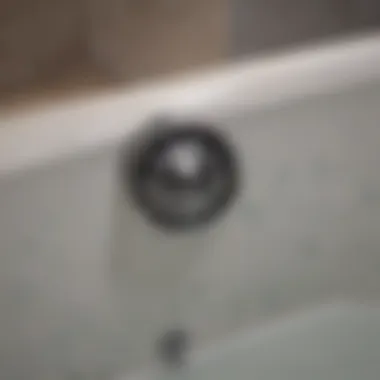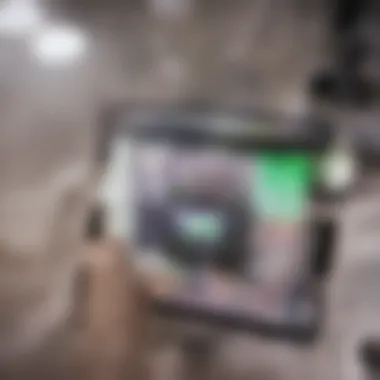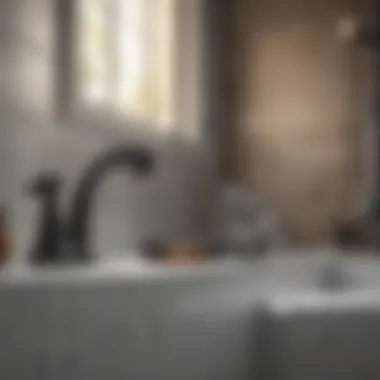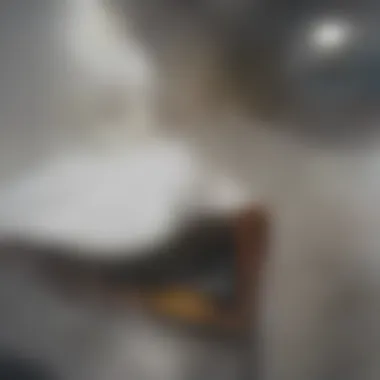Understanding and Resolving Bathtub Drain Issues


Intro
Bathtub drain issues are a common hardship for many homeowners. The inconvenience of a bathtub that refuses to drain can disrupt daily routines and cause significant frustration. Understanding the typical problems related to bathtub drainage is essential in managing these issues effectively.
In this guide, we will explore why certain blockages happen, what steps can be taken to troubleshoot these problems, and how one can implement various solutions. The complexity of plumbing can be daunting, but an informed approach can empower homeowners. We aim to provide a holistic view that is practical and straightforward, enabling readers to tackle their plumbing issues with confidence.
Homeowners might occasionally experience a clogged bathtub drain, which can stem from a multitude of sources. Hair, soap scum, and other debris often accumulate over time, impeding water flow. Recognizing the causes allows for a more effective resolution.
Ultimately, this article aspires to arm readers with knowledge and strategies to handle bathtub drainage issues proactively. By following this comprehensive guide, one can mitigate frustrations associated with plumbing problems.
Preamble to Bathtub Drain Problems
Encountering issues with bathtub drains can fundamentally disrupt daily routines. When a drain fails to operate properly, it creates inconvenience and can lead to further complications if not addressed promptly. Understanding these problems is crucial for homeowners and renters alike. Not only does a functioning drain ensure that water flows away efficiently, but it also prevents the development of unpleasant odors and potential water damage.
The Significance of a Functioning Drain
A bathtub drain that works well is more than just an accessory to the plumbing system. It plays a vital role in maintaining hygiene and comfort. Water pooling in the tub can lead to a breeding ground for bacteria and mold, which can pose health risks. Moreover, frequent blockages can lead to irreversible damage within the plumbing system, resulting in costly repairs. Effective drainage is essential for both functionality and the overall aesthetic of the bathroom space.
Common Drain Issues Encountered
Common problems with bathtub drains include:
- Clogs: Caused by hair, soap, and other debris blocking the passage.
- Slow Drainage: A sign of partial blockage or buildup within the pipes.
- Leaks: May occur around the drain assembly, causing water to pool under the tub.
- Odors: Unpleasant smells can arise from standing water or trapped debris.
Recognizing these issues early can save homeowners considerable time and effort in resolving more severe problems later on. It empowers them to act swiftly and effectively, with the goal of restoring their drain function.
Identifying the Root Causes
Understanding the root causes of bathtub drain issues is paramount for effective resolution. Recognizing these causes allows homeowners to act promptly, potentially saving time and costly repairs. By diagnosing the problem accurately, one can apply the right solutions. This section delves into the various factors that result in drain blockages.
Hair and Soap Residue Build-Up
Hair and soap residues are among the most frequent culprits in bathtub drain issues. Over time, human and pet hair, combined with soap scum from baths and showers, can accumulate in the drain. This mixture creates a thick sludge that blocks the water flow.
To mitigate this problem, regular maintenance is essential. Using a drain cover can prevent hair from going down the drain, while periodic cleaning can keep soap residues at bay. A monthly cleaning routine can significantly reduce the severity of this issue.
Foreign Objects in the Drain
Another common reason for blockages is foreign objects making their way into the drain. Items such as small toys, cotton swabs, and even jewelry can suddenly obstruct drainage. Due to their unexpected nature, these blockages can be tricky to identify without close inspection.
If you suspect a blockage due to foreign objects, it’s advisable to avoid using chemicals that may worsen the situation. Instead, consider manually retrieving the object if visible. In cases where the item is lodged further down the pipe, professional help may be your best option.
Pipe Damage or Corrosion


Pipe damage or corrosion presents a more serious challenge in drain maintenance. Over time, the integrity of pipes can degrade, leading to cracks or rust. Such damage can restrict flow or create blockages. Factors like hard water can hasten this process, depositing minerals that corrode the pipe.
It is wise to periodically inspect pipes for signs of wear. Deteriorating pipes not only cause blockage but can lead to leaks as well. Seeking a professional plumber for an assessment can ensure long-term plumbing reliability.
Clogging in Major Plumbing Lines
Clogging in larger plumbing lines may also contribute to bathtub drainage problems, however, this issue often remains unnoticed until the problem escalates. Major clogs can result from a collection of materials throughout the plumbing system, including grease, food particles, or even tree roots infiltrating underground pipes.
Addressing these issues necessitates professional intervention, as they require specialized tools and knowledge. Regular checks of household plumbing systems significantly reduce the likelihood of severe buildup, contributing to longer-lasting system health.
In summary, understanding the root causes of bathtub drain problems is critical for maintenance and timely interventions. By being aware of what contributes to these issues, homeowners can prevent simple blockages from evolving into major plumbing nightmares.
Initial Diagnostic Steps
Understanding the initial diagnostic steps for bathtub drain issues is crucial for homeowners. This phase not only establishes the nature and extent of the problem but also guides effective troubleshooting. By diagnosing the issue correctly, one can save time, reduce frustration, and minimize the potential costs associated with misdiagnosis or ineffective interventions. Therefore, this section will explore three key diagnostic steps: visual inspection of the drain, testing water flow and drainage, and effectively using a plunger.
Visual Inspection of the Drain
The visual inspection is a fundamental first step in identifying bathtub drain problems. It allows you to assess visible signs of blockage. This includes debris buildup, hair accumulation around the drain opening, or any foreign objects that may have fallen into the drain. Checking for moisture around the drain area also helps identify leaks.
- Look for Obvious Blockages: Items like soap residue or clumps of hair are common culprits.
- Check Drain Parts: Ensuring that the stopper and the strainer are intact is essential.
- Inspect Pipes If Accessible: If you have access to the pipes, look for any signs of corrosion or damage.
This step can reveal straightforward issues that might require simple solutions, saving you from more extensive measures later on.
Testing Water Flow and Drainage
After completing the visual inspection, the next step involves testing water flow and drainage. This helps assess how well the drain functions when in use. Start by filling the bathtub with a few inches of water and then observe how quickly it drains.
- Slow Drain: If the water drains slowly, it indicates a potential blockage either in the drain or further down the plumbing system.
- Standing Water: If water remains even after a long period, you likely have a serious clog that needs immediate attention.
- Unusual Noises: Pay attention to gurgling sounds, as they may signal air escaping through obstructions in the plumbing.
These tests provide immediate feedback on the effectiveness of your drain system.
Using a Plunger Effectively
Using a plunger can often be the first line of defense against drainage issues. This tool can be very effective for minor clogs and is a cost-efficient and straightforward method that homeowners can try themselves. However, applying the plunger correctly is essential for it to work effectively.
- Choose the Right Plunger: A cup plunger or a flange plunger specifically works well for tub drains.
- Cover Overflow Drain: If your tub has an overflow drain, cover it with a wet cloth to create a vacuum.
- Position the Plunger: Place it over the drain and ensure a tight seal.
- Push and Pull: Use quick, forceful thrusts to create pressure and suction, which may dislodge the blockage.
“Effective use of a plunger can save you from a professional call if the clog is minor.”
Mastering these initial diagnostic steps gives homeowners a solid foundation to address drainage issues. Following through with these methods plays an essential role in determining the best course of action for any further treatment or repair.
Tools and Materials for Drain Maintenance
Understanding the importance of tools and materials for drain maintenance is crucial for any homeowner. Correct tools not only streamline the process of unclogging and repairing drains, but also prevent potential damages. If you wish to maintain your bathtub efficiently, knowing what items to have on hand is essential. This article will explore the relevant tools and materials that help you manage drain issues effectively.


Essential Plumbing Tools
Having the right plumbing tools can make or break your drain maintenance endeavors. Here are some significant items:
- Plunger: This basic tool is often underestimated. A good-quality plunger can clear minor clogs easily. The design allows for air pressure to push the blockage through the pipes.
- Drain snake: A drain snake, also called a plumber's auger, is essential for stubborn clogs. It can reach deep into the pipes to remove hair and debris that a plunger might miss. Choose one with a flexible shaft for better maneuverability.
- Wrench: A pair of adjustable pliers can assist in loosening or tightening drain fittings. Ensure it is adjustable to fit various sizes.
- Bucket: Always have a bucket ready to catch any water that spills during drain clearing. Not only does this keep your workspace clean, it avoids excess water damage.
Household Products for Clearing Clogs
Several household products are effective for clearing clogs in a bathtub drain. Here are a few examples:
- Baking Soda and Vinegar: This combination is a natural remedy for minor drain issues. Baking soda works to break down gunk while vinegar effectively dissolves buildup. Just pour a cup of each down the drain and wait for 30 minutes before flushing with hot water.
- Salt: Salt can also be beneficial. When mixed with boiling water, it can help dissolve grease and soap residues that accumulate in drains over time.
- Dish Soap: A few tablespoons of dish soap, followed by hot water, can lubricate pipes and help dislodge clogs from the sides. This can be particularly helpful with grease accumulation.
Safety Equipment Considerations
Safety should be a priority when dealing with drains. Here are some essential safety equipment considerations:
- Gloves: Wearing rubber gloves will protect your hands from harsh chemicals and bacteria present in dirty drains.
- Goggles: Safety goggles are advisable when using chemical solutions. They protect your eyes from any splashes that may occur.
- Mask: If you are using powerful drain cleaners, wearing a mask can prevent inhalation of harmful fumes that could be released.
Implementing these tools and safety measures not only promotes effective maintenance of your bathtub drain but also ensures your personal safety during the process. By understanding and utilizing the right resources, you can tackle common bathtub drain issues with confidence.
Methods for Clearing a Clogged Drain
Bathtub drain clogging can lead to significant inconveniences in daily routines. Identifying effective methods for clearing these drains is crucial for every homeowner. Understanding these methods not only helps to quickly resolve issues but also promotes long-term maintenance of the plumbing system. Implementing the right solution can save both time and money while ensuring that the bathtub functions properly.
Using Chemical Drain Cleaners
Chemical drain cleaners present a popular choice due to their convenience and effectiveness in dissolving clogs. These products typically use strong chemicals, like sodium hydroxide or sulfuric acid, which can break down organic matter. When it’s applied correctly, it can clear away hair, soap scum, and other debris quickly.
However, users should be cautious.
- Read the label: Ensure that the product is safe for your plumbing type. Certain cleaners can damage older pipes.
- Follow instructions carefully: Proper measurements and application are essential for effectiveness.
- Consider safety: Always wear gloves and goggles to protect against splashes.
DIY Techniques for Unclogging
Homeowners often prefer do-it-yourself methods for unclogging drains due to their cost-effectiveness and accessibility. Simple techniques include:
- Boiling Water: Pouring boiling water down the drain can help dissolve soap and grease buildups.
- Baking Soda and Vinegar: This combination can create a natural reaction that helps to loosen clogs. Pour half a cup of baking soda followed by half a cup of vinegar into the drain. Cover for 10-15 minutes and flush with hot water.
- Plunger: A standard plunger can effectively dislodge minor blockages. Make sure to create a tight seal around the drain and pump vigorously.
While these methods may not guarantee a solution for severe clogs, they are excellent initial steps before reaching for harsher chemicals or calling a plumber.
When to Opt for a Professional Plumber
It is not always clear when a clog requires professional intervention. Despite having tried DIY methods, there are instances where calling a plumber becomes necessary. Consider these points:


- Persistent Clogs: If clogs return frequently after attempts to clear them, the issue may be deeper in the plumbing system.
- Multiple Drains Blocked: When several fixtures in the home experience blockage, it may indicate a larger plumbing problem requiring expert diagnosis.
- Uncertainty about Pipe Condition: Sometimes, plumbing issues arise from damaged pipes due to corrosion or tree roots. A professional can assess and provide necessary repairs.
Engaging a professional plumber ensures that the problem is addressed thoroughly. Expertise combined with specialized tools can swiftly resolve issues that simple methods cannot.
"Ignoring persistent drain issues can lead to bigger plumbing problems and costly repairs. Always address the situation promptly."
These methods, whether chemical or DIY, provide valuable options for any homeowner tackling clogged drains. Recognizing when to utilize each tactic enhances overall plumbing maintenance.
Preventive Measures for Future Drain Issues
Addressing bathtub drain issues before they arise can save homeowners significant time and money. Preventive measures are vital for maintaining an efficient plumbing system. Taking proactive steps can reduce the likelihood of clogs and enhance the longevity of plumbing fixtures.
Regular Maintenance Practices
Consistent maintenance is a cornerstone of prevention. It is advisable to inspect drains routinely. Look for any signs of buildup. This can reduce major blockages down the road. Simple actions can include:
- Flushing Drains: Pour hot water down the drain once a week. This helps dissolve any minor residue.
- Using a Plumber’s Snake: Regularly using a snake can help clear smaller clogs before they grow.
- Checking for Slow Draining: If you notice a drain becoming sluggish, act immediately. Slow drainage is a telltale sign of eventual clogs.
Using Drain Screens and Filters
Installing drain screens is an effective strategy. These devices catch hair and soap scum before they enter the plumbing system. Some benefits of using drain screens and filters are:
- Prevention of Large Clogs: Screens can trap debris, preventing it from accumulating inside pipes.
- Ease of Cleaning: They are easy to remove and clean, making maintenance simpler.
- Affordable Installation: Most drain screens are inexpensive and widely available.
Implementing this simple device can greatly reduce frustration related to bathtub drainage.
Educating Household Members on Drain Care
Another important measure is to educate all household members. Everyone should understand what can and cannot go down the drain. Key points to discuss include:
- Avoiding Non-biodegradables: Items like cotton balls, dental floss, and wipes should not be flushed or washed down.
- Proper Use of Soap Products: Encourage the use of quality soap products. Some soaps are more prone to buildup than others.
- Regular Reminders: Regular discussions about drain care can reinforce behaviors that promote cleaner drains.
"An informed household is essential for preventing future drain problems."
By implementing these preventive measures, homeowners can mitigate many common drain issues that may arise. Taking these steps ensures a more efficient plumbing system and promotes a healthier home environment.
Epilogue and Final Thoughts
Recap of Key Points
With the potential for larger problems looming, it is vital to recap the essential points discussed throughout this article:
- Proper identification of the root causes of tubs not draining can save time and resources.
- Regular maintenance practices are vital in preventing future complications. Simple actions such as clearing hair and soap buildup after every use can make a big difference.
- Utilizing tools and household products appropriately can lead to successful unclogging efforts, while knowing when to call a professional can prevent unnecessary damage or troubles.
The Importance of Addressing Drain Issues Promptly
Prompt attention to drain issues is equally important. Delaying resolution can exacerbate the situation, transforming a minor clog into a major headache. Many homeowners underestimate the power of timely action. Here are a few considerations:
- Avoid Further Damage: Early detection of problems helps mitigate potential damage to pipes and surrounding areas.
- Cost Efficiency: Taking action sooner can potentially save money in expensive repairs that arise from neglected issues.
- Health Benefits: Keeping pathways clear can greatly reduce risks associated with mold and bacteria growth, promoting a healthier environment.
In summary, tackling bathtub drain issues promptly not only preserves the condition of your bathroom but also enhances the overall health of your living space.







